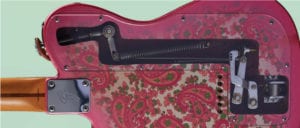Pitch Perfect: A History of the B-Bender
Find out what’s behind this curious device that can transform the pitch of your guitar on the fly.
Occasionally, Fender is asked if it still offers a Telecaster model equipped with something called a “B-Bender.” The answer is no, not at the moment, not since the B-Bender Telecaster went out of production in the 2000s.
But what is this mysterious device? And how did it come to be?
The device is the aforementioned B-Bender, and, while it didn’t always have that name, that’s what most guitarists know it as.
The B-Bender is a mechanical device that raises the pitch of a Telecaster’s B string by a whole tone (up to C#), producing plaintive, sinuous bends very much like those produced on a pedal steel guitar. This is accomplished by spring-loaded levers inside the guitar’s body, which connect the bridge to the strap button on the upper bout. The strap button itself is attached to a lever that moves up and down about an inch. When you wear the guitar over your shoulder and you push the neck downward, the guitar strap pulls the strap button upward, activating the lever system and raising the pitch of the B string.
The B-Bender was invented by two country-rock pioneers, guitarist Clarence White and multi-instrumentalist Gene Parsons, both of whom played in Nashville West and the Byrds, among other acts, in the late 1960s and early 1970s. Their device was called the Parsons/White Pull-String, and it was designed to fit White’s 1954 Telecaster (White was killed by a drunk driver in 1973; his guitar with the prototype bender mechanism is now owned by Marty Stuart, who has played it often).
After licensing the Parsons/White Pull-String to another manufacturer in the early 1970s, Parsons renamed it the StringBender and began making and installing it himself in 1973. He produced hundreds of units over many years before partnering with California folk musician Meridian Green in 1989 to increase production. Parsons and Green eventually approached the Fender Custom Shop, resulting in the signature Clarence White Telecaster model, which was introduced in 1995 and featured the modified “Parsons-White B-Bender.” About 200 of these guitars were built through 2002.
Not long after the Custom Shop’s 1995 introduction of the B-Bender-equipped White model, however, Fender also decided to introduce a production version of the guitar. Parson and Green modified the B-Bender once again for the mass production of this instrument, which was introduced in 1996 as the American Standard B-Bender Telecaster. A three-pickup version of this two-pickup model was introduced in 1998.
Fender released a version of the instrument — the aforementioned B-Bender Telecaster — appeared in 2000, but it is no longer in the Fender line. It used what is now called the “Custom Fender/Parsons/Green B-Bender System,” which was adjustable to allow no change in pitch, a half-step rise in pitch (C) or a whole-step rise in pitch (C#).
If the whole concept of the B-Bender sounds a bit strange, keep in mind that you’ve very likely heard it before. You might not own a copy of the Byrds’ Live at the Fillmore: February 1969, which features Clarence White’s sterling use of the B-Bender, but you probably have heard “All My Love” by Led Zeppelin and “Peaceful Easy Feeling” by the Eagles, both of which feature a B-Bender. Other guitarists who have put a B-Bender to good use include James Hetfield (Metallica), Pete Townshend, Albert Lee, Rich Robinson (Black Crowes), Mike Campbell (Tom Petty & The Heartbreakers), Peter Buck (R.E.M.) and David Gilmour.
Naperville Music, your home for everything Fender.

